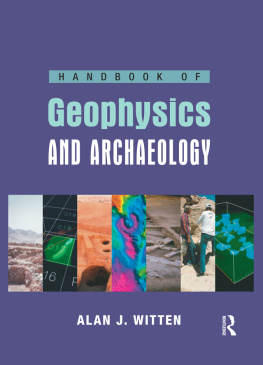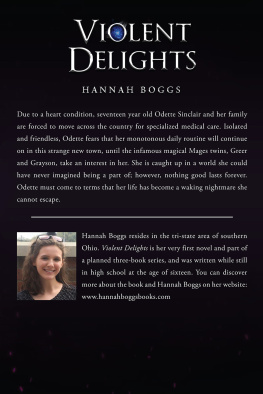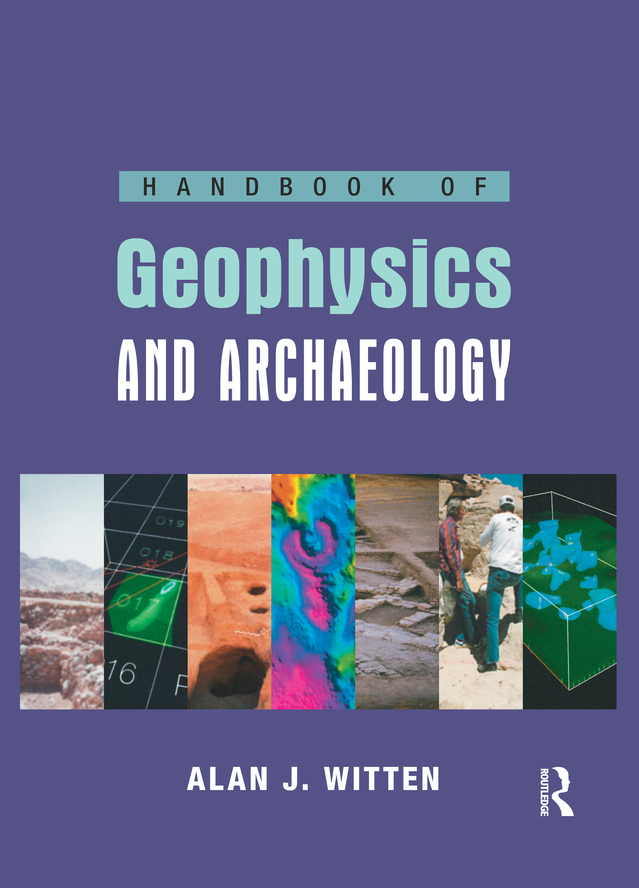Handbook of Geophysics and Archaeology
Handbook of Geophysics and Archaeology
Alan J. Witten
First published 2006 by Equinox, an imprint of Acumen
Published 2014 by Routledge
2 Park Square, Milton Park, Abingdon, Oxon OX14 4RN
711 Third Avenue, New York, NY 10017, USA
Routledge is an imprint of the Taylor & Francis Group, an informa business
Alan J. Witten
All rights reserved. No part of this book may be reprinted or reproduced or utilised in any form or by any electronic, mechanical, or other means, now known or hereafter invented, including photocopying and recording, or in any information storage or retrieval system, without permission in writing from the publishers.
Notices
Practitioners and researchers must always rely on their own experience and knowledge in evaluating and using any information, methods, compounds, or experiments described herein. In using such information or methods they should be mindful of their own safety and the safety of others, including parties for whom they have a professional responsibility.
To the fullest extent of the law, neither the Publisher nor the authors, contributors, or editors, assume any liability for any injury and/or damage to persons or property as a matter of products liability, negligence or otherwise, or from any use or operation of any methods, products, instructions, or ideas contained in the material herein.
ISBN 13: 978-1-904768-59-3 (hbk)
ISBN 13: 978-1-904768-60-9 (pbk)
Library of Congress Cataloguing-in-Publication Data
A catalogue record for this book is available from the Library of Congress
Typeset by Forthcoming Publications Ltd
Contents
Guide
Foreword:
Unearthing InspirationAn Author Remembered
You cannot teach a man anything; you can only help him find it within himself.
Galileo Galilei
The temperature was at least 115F and it was only 10:30 in the morning. He was in his element.
I feel this is the most appropriate way to begin this book and to pay homage to the late Dr Alan J. Witten. It has been a struggle finding not only the right words, but the right atmosphere, ambiance, and attitude to embody a man who never lived by anyone's definition or within any established boundaries. It could have been just as easy to start with a grandiose image from one of his innumerable adventure stories. 'The rows of grape vines that lined the shores of the Aegean Sea were a visually surreal complement to our job of finding what some experts had surmised to be the mythical city of Atlantis' was one option. Or, 'It took Dr Witten only a matter of hours to accomplish what countless experts had been unable to do through years of devoted effort: uncover a major illicit drug tunnel that connected the Mexican border with California'. I also toyed with using, 'One of the most successful pirates of all time hid his treasures from the world for 500 years. That was until Dr Witten drew a mathematical treasure map where electromagnetic induction, as opposed to an archaic "X", marked the spot.'
All of these images vividly and accurately express the Indiana Jones-meets-Albert Einstein personality and charisma of Dr Witten. Yet while these Stories are as exciting and adventuresome as those of today's most popular movies, they do not wholeheartedly capture the spirit, energy, and will Dr Witten demonstrated every day. So I start his book not with one of these picturesque field settings or swashbuckling adventure stories, but rather with a personal narrative of an everyday tale of Dr Witten set in the most unconventional of surroundings. A story staged in the most unappealing of conditions, but containing some of the most exciting of opportunities. This is where he thrived. No matter what the setting, Dr Witten outshone it with his resolve. No matter what the level of adventure, Dr Witten outpaced it with his enthusiasm. His is a story of determination and heart, where the backdrop only adds a scenic or interesting detour to an intended goal. Sol began his book this way, in what will hopefully be a fitting testimonial to his work, his life, and his memory.
The temperature was at least 115F and it was only 10:30 in the morning. He was in his element. Dr Witten had led a team of geophysicists, geophysics students, and archaeologists into the Jordanian desert in search of an Iron Age city missing for over 2500 years. This was not the first of such expeditions Dr Witten had led. For years he had journeyed halfway across the globe, both to this desolate wasteland and to other unusual locales, in search of new challenges and opportunities to implement his technology. If anything, a trip like this was a regular occurrence for Dr Witten. But the students who accompanied him thousands of miles from the classroom never felt so uniquely extraordinary as they did here among the sand dunes. I was a member of this extraordinary team and, like the group, I was optimistic and excited for the opportunity to take science and make it practical for the first time.
Besides the enthusiasm and blistering heat of the day, I remember sitting under a makeshift tarp, drenched from the heat and gulping down water after only an hour of carrying an EMI unit over the dunes. I remember fighting off the flies for a spot of shade below the tarp, searching, in vain, for the energy to get back under the Arabian sun and work. But what I remember most, and what is surely a vivid memory for all those who were present, is of watching Dr Witten cover acre after acre of desert to acquire the data needed to discover the treasures buried beneath the sand. One by one, students 30 or more years his junior would exhaustedly stumble to shelter and water, too tired or too hot (or both) to continue. Yet alone in the field Dr Witten tirelessly went about his work, never complaining, never compromising, and absolutely never quitting. Only late in the afternoon, as he sat in the back of our field vehicle processing the team's data, did Dr Witten finally take a sip of water, relax, and admire another fine day's labor. Then he did it all again the next day. And the next. And the next. Working with Dr Alan J. Witten was not merely inspiring, it was exhausting. And this was just another day at the office for my father.
At the heart of my father's success and at the core of his drive was his students. Whether it was the spark he induced in an otherwise uninspired undergraduate, or the need to increase a class size after students personally pleaded to take his lectures, his greatest joy his most valued reward came from students. While his uncanny knowledge and understanding of geophysics made him an intellectual success, his ability to connect to his broad student base made him a celebrated teacher. With his tie-dyed t-shirts, unorthodox one-on-one final exams, and laid-back demeanor, he was an educator who truly understood his consumers. He proved that, from Ph.D. candidates to freshman English majors, geophysics could be fascinating, practical, and fun. If a student could not grasp how magnets could be used to image the buried world, he would casually tell a story of the Great Pyramids of Egypt, of the lost tombs of Pharaohs, and of hidden chambers beneath sand and rock and, miraculously, the concept became clear. When electromagnetic induction sent waves of confusion through a class, he calmly conveyed a history lesson on pirates, scuttled ships, and buried treasure and the confusion gave way to intrigue and understanding. And just when he piqued his students' curiosities, he would break out the slideshow. Now they were hooked.












